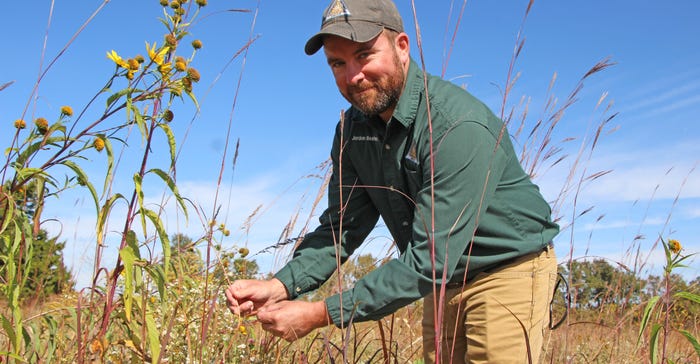
Jordon Beshears started as a wildlife biologist in Lincoln County, Mo., and worked about 18,000 acres in the St. Louis district managing land for quail and obligate grassland birds.
Then, five years ago, he took that expertise to rural Missouri and began helping farmers create spaces where livestock, row crops and wildlife not only coexist but also thrive.
Beshears, who works as a private land conservationist for the Missouri Department of Conservation (MDC), spends much of his time developing plans for prairie plantings. For farmers in northern regions of the U.S. where native rangeland exists, he notes that in states such as Missouri, it is a different ask of farmers.
“This area was a glaciated prairie, and now the majority is in agriculture production,” Beshears says. “So, land conversion has been a big deal here.”
Programs such as the Audubon Conservation Ranching Program, along with federal programs like the Environmental Quality Incentives Program, help. These offer incentives to farmers for incorporating native forages in pastures or pollinator plantings around row crop fields, Beshears explains, and make a real difference on grassland bird species populations.
The Missouri Department of Conservation conducts bird surveys every summer. Beshears sees an increase in dickcissels, Henslow’s sparrow, bobwhite and meadowlark in the east-central and northern regions of the state, in part because of these types of initiatives.
Yet, while transforming a farm to increase wildlife — especially bird habitat — is good for the ecosystem, Beshears realizes any type of change for a farmer “has to turn a profit.”
“We need to find the balance where natives plantings help raise healthy livestock and also benefit birds and wildlife,” he says. “Farmers have always been progressive, and with today’s input costs for chemical, fertilizer and seed, that’s more apparent than ever. Adding native forages and annual cover crops to grazing systems and installing prairie or pollinator plants on less productive row crop operations are just a couple examples. These practices improve their bottom lines, and those are the operations where we’re seeing good numbers of quail and other wildlife.”
Getting there
Older pastures or hayfields were often planted to a single species of introduced grasses. Today, Beshears recommends a variety of grasses or forage types for better land, farm and wildlife benefits.
A typical native forage mix may include species such as big bluestem, indiangrass, eastern gamagrass, switchgrass and a variety of wild ryes. The exact mixture of grasses depends on the soil types where the grasses are planted. Beshears helps farmers identify what works on their land and operation.
Native forages are no different than any crop you plant on the farm, he says. Proper preparation ahead of planting is critical, and natives really aren’t difficult to establish if done correctly.
“Today’s seed mixes and herbicide regimens make the establishment process must quicker than most people realize,” Beshears explains. “Often times, the newly planted forages are out of production, meaning they aren’t grazed or hayed, for just the first growing season.”
However, after the first year, Beshears says the forage production increases.
Good for cattle
For livestock owners to find the greatest benefit of planting native grasses, pastures need to be managed.
Left ungrazed, these areas grow tall, thick and rank. “What the cattle do for you, habitat wise, is they break that structure up depending on how you graze,” Beshears explains.
Some farmers allow free-range grazing, where they find certain plant species they like and then leave others. However, rotational grazing, or only offering access for a certain amount of time, forces the cattle to consume other species.
Beshears says the right native grass mix with property management allows farmers to graze in the heat of summer and well into the fall months. “It is a way to increase grazing days, while helping wildlife,” he says.
Good for birds
The benefits of native plants for birds start in spring.
Switchgrass is one of the first warm-season grasses to show through. Indiangrass and big bluestem also are warm-season bunch grasses. They put on a lot of leafy material, which is what livestock producers want for forage, but leave a lot of bare ground underneath. When grassland birds fledge, it offers excellent habitat to move around in, Beshears explains, especially Bobwhite quail.
“The day quail hatch they are on the move,” he says. “If they hatch out on a fescue or sod-forming grass pasture, they do not have much of a chance. They need a lot of bare ground under a grass canopy of overhead cover.”
Beshears says quail are an indicator species for MDC on a healthy ecosystem. “When you hear or see those Bobwhites, you have a pretty healthy system.”
Need help with wildlife plan?
As a first step, Beshears says, a representative from the local USDA field office will visit your property. They will then make recommendations based on farm conditions, along with your goals and objectives as a producer to help you make the most out of your operation.
USDA or MDC staff will provide technical assistance throughout the entire process. They write plans specific to your project, including herbicide recommendations and timing, seed mixes and planting specifics, as well as other maintenance requirements.
Cost share is available to producers for practices such as planting native warm- and cool-season forages, planting annual cover crops for grazing, and woodland and riparian exclusion fencing. EQIP and the Conservation Stewardship Program are two popular cost-share programs administered by USDA.
Beshears says MDC also has funding available through its Landowner and Community Assistance Program. Cost-share rates vary by program but take several factors into account, including seed, herbicide, fertilizer and implementation costs.
Beshears says now is the time to talk about planting natives in pastures and along crop fence rows. He encourages farmers to contact their local USDA or MDC office for more information on programs available.
About the Author(s)
You May Also Like






